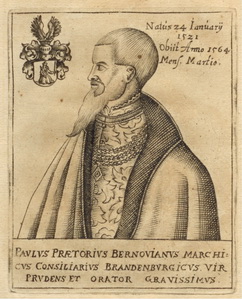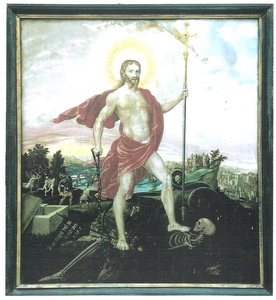The family descends from Paulus Praetorius or – with his common – Schultheiß (1521-1565) as their progenitor. It was in 1562, when Paulus Praetorius adopted Samuel Schmidt with imperial approval , son of an early deceased friend from university and scholar of Luther, who later became the protestant pastor Sebastian Faber (Schmidt) at St. Nicolas in Potsdam. Paulus Praetorius conferred his family´s coat of arms, bestowed by the emperor Ferdinand I. as a sign of his nobility, upon his adoptive son Samuel Schmidt. The respective document of confirmation is kept in the Austrian State Archives in Vienna. Throughout all generations the family lived in perpetual respect for their progenitors Paulus and Samuel Praetorius .

Paulus Praetorius (1521-1565) (by Martin Seidel)
Paulus Praetorius was born in Bernau near Berlin as a son of a brewer and as a grandson of the cities mayor. After studying at the university of Frankfurt/Oder, the so-called “Viadrina”, he was appointed principal at the school in Bernau. Elector Joachim II. entrusted him with the education of his younger sons. Praetorius also became advisor of the young archbishop of Magdeburg and administrator of the diocese of Halberstadt, electoral Prince Friedrich of Brandenburg. After the early death of Prince Friedrich at the age of 22, his younger half-brother Sigismund of Brandenburg succeeded him in his functions. Paulus Pratorius became his counselor in the dioceses administration and served him as a representative in diplomatic missions. Among others Paulus Praetorius supported the efforts of the council of Halle to establish a secondary school after the Lutheran concept in a former abbey. Moreover, Paulus Praetorius was closely connected with several contemporary distinguished personalities such as the reformer Philipp Melanchthon. The correspondence with him is still well-preserved. Furthermore, he wrote historical works that were printed in Frankfurt/Oder. Along with Prince Sigismund , he gave the sculptor and medalist Hans Schenk (or Scheußlich) the order to erect a renaissance-style tomb in the dome of Halberstadt, which is now considered one of Schenk’s greatest works. Even today, traces of Paulus Praetorius´ life can still be found, e.g. the sandstone epitaph at the St. Nicolas Church in Berlin and in an oil painting he donated in remembrance of his parents to the gothic St. Mary’s Church in Bernau. The painting shows the resurrection of Jesus focusing on overcoming death and is accredited to the court painter Michel Ribestein.

Paulus Praetorius commissioned different artists to create several portraits, such as a medallion that was probably designed by Schenk, and his lately restored burial place at the “Stadtgottesacker” in Halle, which is considered to be a very unique cemetery from the time of the German Renaissance. With his last will and testament Paulus Praetorius , who had become a prosperous man, established a foundation that was supposed to support talented children of his hometown with poor financial background. This foundation pursued this goal up until the 20th century, when it perished due to the big inflation. Significantly more sources concerning Paulus Praetorius are available now due to the reunion of Germany. Also, the secondary school of his hometown Bernau has born his name since 1995. The adoptive son Samuel Praetorius studied law at the Universities of Wittenberg and Frankfurt/Oder (the “Viadrina”), where he served as dean and syndic of the law department. In his late years he was an aldermen, municipal judge and mayor.
His son Tobias Praetorius (1576 – 1644) studied law at the Viadrina as well. Crucial for the course of his further life and the associated future of the family was his acquaintance with Christoph von Schaffgotsch, owner of large estates at the Riesengebirge (Giant Mountains) in Silesia.
After the early passing of Christoph von Schaffgotsch in 1601, Tobias Praetorius was appointed private tutor of the six-year-old son Hans Ulrich v. Schaffgotsch. Tobias married into the Silesian family Böhm von Böhmfeld and was later appointed estate manager of Schmiedeberg by his foster son. The strong wish to become landowner himself might have arisen from this function. During the Thirty-Years-War Hans Ulrich von Schaffgotsch rose to the rank of a general of the Habsburg monarchy, despite his protestant denomination. Tobias Praetorius supported him in his position with the recruitment of troops funded by different mortgages on the Schaffgottsch´ estates. The close connection to General Wallenstein led to Hans Ulrich v. Schaffgotsch´s execution after Wallensteins disgrace and assassination . Tobias Praetorius benefited from the rearrangement of the family´s assets, with his own mortgages on the Schaffgotsch’s estates enabling him to purchase property of his own.
This property allowed the next generation to rise to Bohemian knighthood. This social advancement was absolute necessary for the enduring security of the family´s assets.